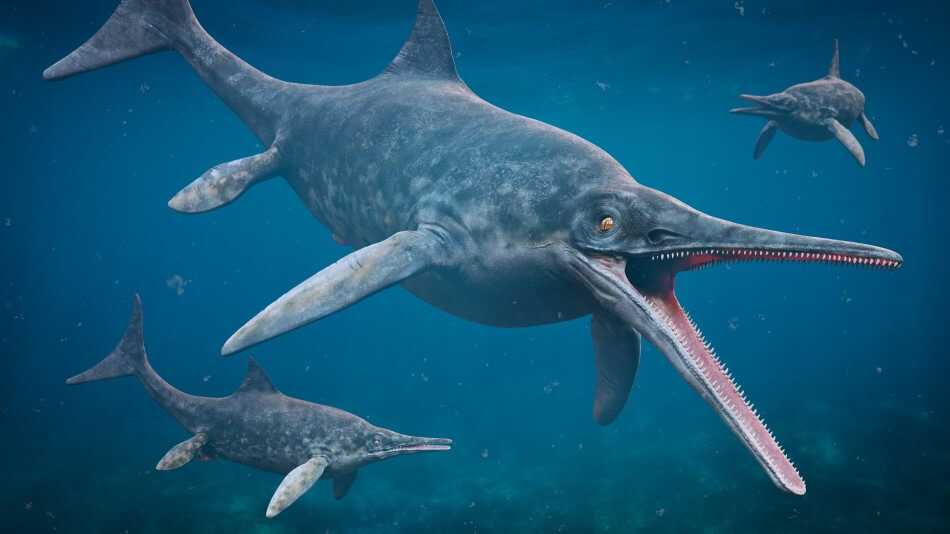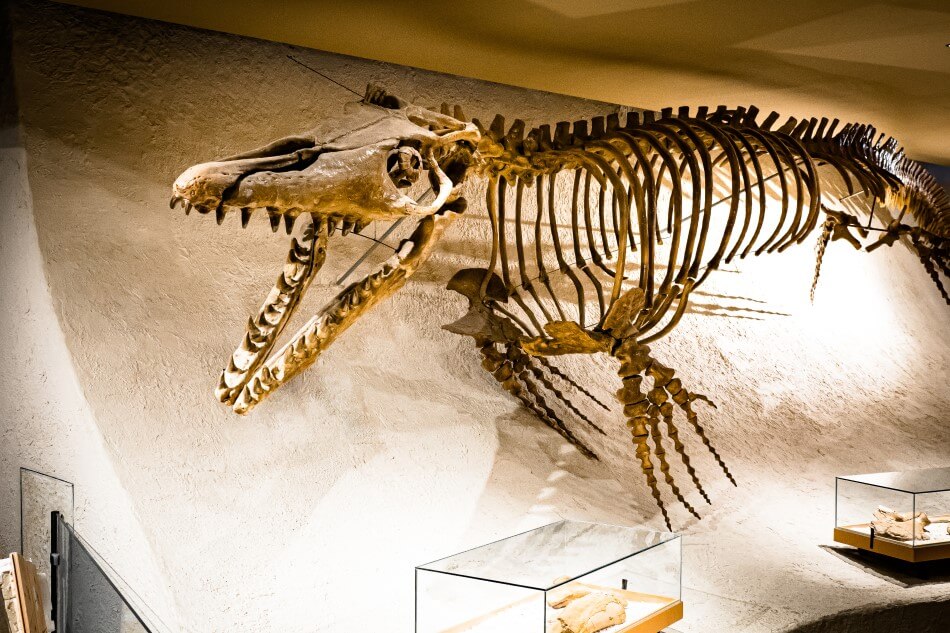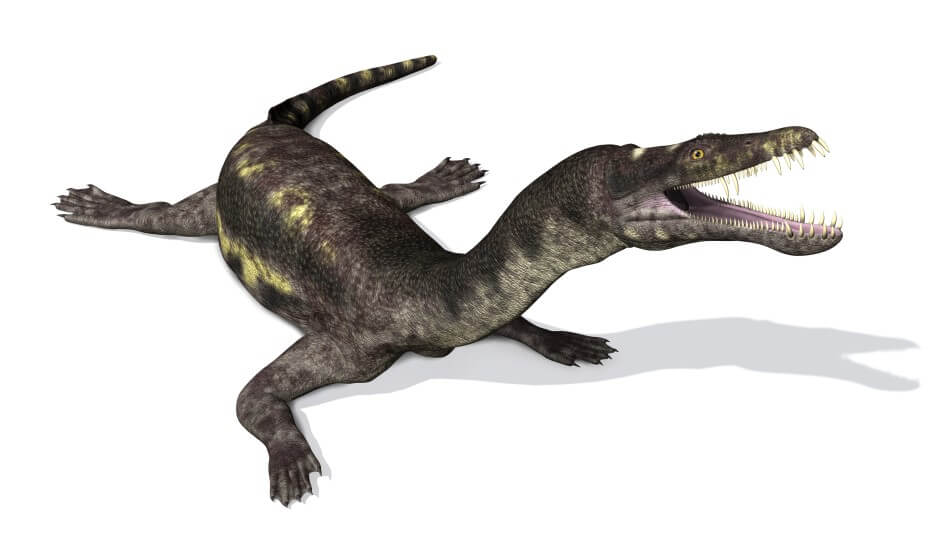For many, many years, the debate about the existence of Nessie, the Loch Ness Monster, has been subject to public scrutiny with many believing that Nessie is (still) living proof that dinosaurs exist now. But, this is not the case – if there is still a long-necked water-dwelling creature in the cold depths of Loch Ness, it is definitely not a dinosaur!
Water Dinosaurs Didn’t Actually Exist
The evolutionary definition of a dinosaur is a reptile that would live and hunt on land. It had limbs for walking which were perpendicular (Maths catch-up!) to its body, unlike today’s reptiles, such as lizards and crocodiles, with legs protruding from the sides of their bodies. There were some dinosaurs who were able to swim, including the ferocious Spinosaurus and Eustreptospondylus, and some which would wade, including the fish-loving Baryonyx, but none of them lived primarily in the water. The water was only a temporary domain, much like it is for seals or humans today.
So, if there are no ‘water dinosaurs’, what were those huge creatures inhabiting the seas of the prehistoric world? The terms ‘marine’ or ‘aquatic reptile’ are often used but, in the eyes of the Jurassic World watching public, water or sea dinosaurs are much more menacing monikers which appear to be here to stay for the foreseeable future.
There Were Many Types of ‘Water Dinosaur’
If you have ever been lucky enough to visit the Natural History Museum of London, you will definitely remember the super-sized skeleton of the biggest animal on Earth, a 25.2m long Blue Whale named Hope, suspended from the ceiling by wires and chains. But, compared to some of the mammoth monsters living in the seas millions of years ago, Hope is simply small fry! In fact, some of Hope’s ancestors may well be included in the long list of the biggest dinosaurs in the sea ever.
Basilosauridae Were Primitive Whales

Basilosaurus (said bah-see-low-sore-us) was a primitive species of whale from the Basilosauridae family, living around 40-35 million years ago in the Late Eocene Period, which could grow up to 60 feet in length. Originally thought to have been a reptile when it was first discovered in 1832 in Louisiana, USA, then named in 1834, Basilosaurus means ‘king lizard’. But this walloping whale was treated as anything but a king!
In south-eastern US states, long before proper identification was made, residents used the huge, hard, and handily-shape fossilised bones of this ancient beast to hold up fireplaces and as foundation posts for houses. In addition to this, poor Basilosaurus was an innocent bystander in an elaborate hoax by a hustler named Albert Koch in 1945. Using Basilosaurus bones, he reassembled them to form a massive 114ft skeleton and named them as a ‘Hydrarchos’, then charged money for admission to see this ‘ruler of the waves’. Koch was rumbled when visiting naturalists paid special attention to the many different ages and origins of the teeth filling the ferocious fossil’s mouth!
And finally, Basilosaurus is not even able to claim the crown as being ‘king’ of the whales. That title goes to Leviathan, a giant killer whale weighing in at more than 50 tons, which scoured the seas about 25 million years later than Basilosaurus.
Ichthyosaurs Were Just Like the Fish We See Today, but Bigger!

Ichthyosaurs (ick-thee-oh-sores), or ‘fish lizards’ in Ancient Greek, were first discovered by British palaeontologist Mary Anning and were commonplace in the world’s oceans from the beginning of the Triassic Period, 250 million years ago. They were a diverse genus, meaning that there were very different types of Ichthyosaur, with some living in coastal waters while others kept to the deepest parts of the ocean. As their name suggests, these scaly swimmers looked very similar to fish of today, but they were a whole lot bigger! In fact, the largest ‘sea dinosaur’ in history is a species of Ichthyosaur.
In 2004, a study of a fossil find in British Colombia, Canada, was published. In it, palaeontologists described the discovery of an Ichthyosaur which was an amazing 75ft in length; it was named Shonisaurus sikanniensis by its finders and was the largest skeleton of an Ichthyosaur ever discovered. Then, in 2011, scientists re-examined the remains and, after finding some differences to other Shonisaurus fossils, reclassified them as being from a different type of Ichthyosaur, Shastosaurus sikanniensis. And then, just five years later, in 2016, an amateur fossil hunter made a massive discovery on a beach in the county of Somerset, UK. Although part of an incomplete skeleton, the gigantic jawbone which was found in the cliff-face has allowed palaeontologists and marine specialists to calculate that this new type of Ichthyosaur was an astounding 85ft long. And, using this and other amazing Ichthyosaur finds to back their theories, scientists think that there are even larger fossilised remains of the biggest water dinosaur that ever lived, just waiting to be found.
Mosasaurus Was the T-Rex of the Ocean

While dinosaurs which walked on four or two legs such as Triceratops and Tyrannosaurus Rex dominated on land, water dinosaurs of a different type ruled the oceans of the Cretaceous Period. Mosasaurus (said mo-zah-sore-us) was a type, or genus, of mosasaur, who were closely related to modern day snakes and lizards but were strictly marine predators with huge jaws and razor-sharp cone-shaped teeth. Named ‘Meuse lizard’ in Greek after the Nederlands’ river where it was first discovered, Mosasaurus was found at a time before thoughts of evolution or dinosaurs became public knowledge. It was also a time when the idea that there were creatures on Earth which had become extinct was a controversial one and caused great upset to the strict religious thinkers of the day.
Living during the Late Cretaceous Period, about 70 – 65 million years ago, and with some species growing as large as 17m or 55ft long, Mosasaurus was not the biggest dinosaur in the sea at the time. But it was the most ferocious! Known as the T-Rex of the sea, mosasaurs are becoming almost as infamous as their counterpart on the land. A massively exaggerated type of the species appeared to effortlessly devour a Great White Shark in a Sea World-style show, although squid and crustaceans were more likely to be its dinner of the day, only to then rise from the display depths to save the day in the monster movie, Jurassic World.
The Loch Ness Monster Could Be a Species of Plesiosaur

Another dominant genus of ‘water dinosaurs’ were the Plesiosaurs. Plesiosaurus (said plee-see-oh-sore-us and meaning ‘almost lizard’) was first discovered by Mary Anning (again – she kept busy!) in Dorset, UK, in 1823. Similar in looks to a long-necked turtle with no shell, these rampant reptiles swam the seas from the early Jurassic Period to the end of the Cretaceous Period and could grow up to 14m long. As palaeontologists believe that Plesiosaurus was not actually the best at swimming, its varied diet is understandable and its amazingly strong jaws and sharp teeth meant that it could munch on anything from fish to molluscs with no hesitation.
Interestingly, some experts believe that there are still Plesiosaurs today, floundering around in modern day seas – and they’re in British waters! In 2002, a former scientific officer from the Natural History Museum released video footage of, what appears to be, a long-necked, small-headed creature paddling its way along the coast of Cornwall in the UK. Unfortunately, other professionals haven’t been able to agree on what exactly can be seen so little has been made of the reptilian recording.
There is, however, a very well-known Plesiosaur which often does make the headlines. Reported to be inhabiting the huge Scottish lake, Loch Ness, there have been hundreds of eye-witness accounts of Nessie, the Loch Ness Monster, taking time from swimming the dingy depths of its Loch Ness home to extend its long neck and small head above the water and pose for some very blurry, but instantly recognisable, photographs. However, despite the physical similarities, palaeontologists say that Nessie cannot be a Plesiosaurus as it was a marine reptile and wasn’t adapted to freshwater life. But, as we know, evolution proves that living things do adapt to suit their environment, so maybe a sea dinosaur in a Scottish lake is not such an unimaginable occurrence after all.
The First Water Dinosaurs Were the Nothosaurs

Nothosaurus (said no-tho-sore-us) is Greek for ‘false lizard’ and was one of the very first water dinosaurs. This flexible fish fancier was prolific during the Triassic Period, about 250 – 200 million years ago, and is thought to have been a distant ancestor to the bigger plesiosaurs which came later in time. There have been as many as 12 different types of Nothosaur already identified and these range worldwide, from western Europe to eastern Asia with large amounts of fossils being discovered to provide dinosaur scientists with lots of valuable information.
With its streamlined body and long, webbed toes, Nothosaurus had a similar shape to the seals we see today, just with a very long neck! Indeed, dinosaur scientists have named Nothosaurs as the seals of the Triassic and think that, although they were adapted for marine life, they actually behaved more like a seal too, diving from rocks, speedy and agile in the water, and clumsy and awkward on dry land.
Nothosaurus also had very distinctive dentistry! Its long, sharp teeth extended out of its mouth and were shaped to mesh together when its jaw was closed, forming an unescapable cage for whatever slippery fish or small marine reptile was on the menu of the day.
Again, not the biggest water dinosaur and growing up to only around 7 metres, Nothosaurus was different to other marine reptiles of the time because it still had four strong, working legs, which leads palaeontologists to believe that it could still walk on land, probably just like a sealion does!
Helicoprion Was a Prehistoric Shark With Teeth in a Coil

Although it could never really be mistaken for a sea dinosaur, Helicoprion (said heh-lee-cope-ree-on) had to be included in this list of monstrous marine creatures. Its name originates from the Greek for ‘spiral saw’ and it is possibly one of the most mysterious and puzzling fossil discoveries of them all.
As the name suggests, Helicoprion had razor-sharp teeth which, uniquely, were arranged in a coil or spiral shape. And this is actually all palaeontologists have had to go on. The only fossilised remains of Helicoprion are the whorls of teeth it is known for, and even these were nearly disregarded as being ammonites or nautilus, the snail-shell shaped fossils commonly found worldwide. Luckily, it was soon realised that this was actually part of a shark-like fish and, since 1899 when the discovery was made, speculation as to where such a part would fit on the body of a shark has run riot.
Over the 100 years and more since Helicoprion was discovered, there have been hundreds of theories and suggestions as to how it would have looked and how its roll of dangerous dentistry would have worked. Finally, using CT scanning equipment, fossil scientists think they have found out.
It seems that the hellish Helicoprion held its curly teeth inside its bottom jaw, with a kind of rolling system where teeth would be lost and would be instantly replaced with new ones from the coil. It has also been discovered that these were basically the only teeth Helicoprion owned, with virtually none in the top jaw. So now, the race to work out how it could actually eat is on in marine biology circles!
As well as all of this astonishing evidence, advanced technology has also provided evidence that Helicoprion lived from way back at the start of the Permian Period 290 million years ago, until 40 million years later at the beginning of the Triassic Period. And that includes surviving through the devastating Permian-Triassic Extinction Event which destroyed a massive 95% of marine wildlife occupying the oceans at the time!
Finally, it seems that Helicoprion can indeed be included in our list of marine monsters as new evidence shows that it could reach lengths of 20 – 25 feet long, making it a worthy addition. However, scientists have now concluded that Helicoprion was definitely not a dinosaur. But, nor was it a shark. It was actually a type of fish – to be more specific, even with its impressive whirling teeth and super size, Helicoprion was a type of ‘rat-fish’! Slightly disappointing in terms of striking fear into the hearts of all, but there is no doubt that Helicoprion was definitely a danger lurking in the deep.
Final Thoughts
These marine monsters are just a few of the genera of reptiles, whales and fish which ruled the prehistoric waves and include some well-known names. But there are so many more, and even more discoveries are being made every day – maybe as many as there are fish in the sea!
Swimming & Water Dinosaur FAQs
What is the dinosaur that lives in the water?
No dinosaur lives in the water! But what you would have found in prehistoric seas were creatures such as Nothosaurus, Basilosaurus, Mosasaurus, Icthyosaurus and Plesiosaurus to name just a few. By definition, dinosaurs were reptiles which lived and hunted on land and walked on either two or four legs. The creatures living in the seas during prehistoric times were marine or aquatic reptiles or primitive whales (mammals) and fish.
What is the largest water dinosaur?
Icthyosaurs were the largest ‘water dinosaurs’, with the most recent fossil discovery in Cornwall allowing palaeontologists to calculate the size of the as-yet-unnamed species as being over 85ft long. By definition, dinosaurs were reptiles which lived and hunted on land and walked on either two or four legs. The creatures living in the seas during prehistoric times were marine or aquatic reptiles or primitive whales (mammals) and fish.
What is the most famous water dinosaur?
There are two contenders for this title. The mighty Mosasaurus with its massive mouth and a starring role in Jurassic World. Or, the perplexing Plesiosaurus which may, or may not be, the historically famous Loch Ness Monster.
What is a marine dinosaur called?
A sea/water/marine dinosaur is actually not a dinosaur. By definition, dinosaurs were reptiles which lived and hunted on land and walked on either two or four legs. The creatures living in the seas during prehistoric times were marine or aquatic reptiles or primitive whales (mammals) and fish.
